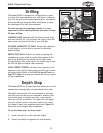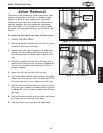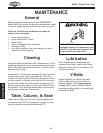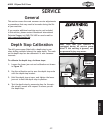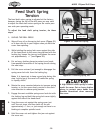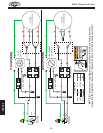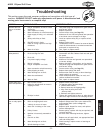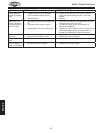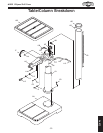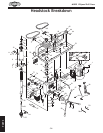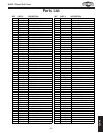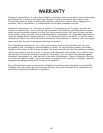
-31-
D('*0()$Jg\\[;i`ccGi\jj
J<IM@:<
KiflYc\j_ffk`e^
This section covers the most common problems and corrections with this type of
machine. N8IE@E>;FEFKdXb\XepX[aljkd\ekjlek`cgfn\i`j[`jZfee\Zk\[Xe[
dfm`e^gXikj_Xm\Zfd\kfXZfdgc\k\jkfg
GIF9C<D GFJJ@9C<:8LJ< :FII<:K@M<8:K@FE
Machine does not
start or a breaker
trips.
1. Plug or receptacle at fault or wired
incorrectly.
2. Start capacitor is faulty.
3. Motor connection is wired Incorrectly.
4. Power supply is faulty, or is switched
OFF.
5. Safety switch key at fault.
6. ON/OFF switch is faulty.
7. Cable or wiring is open or has high
resistance.
8. Motor is at fault.
1. Test power plug and receptacle for good contact
and correct wiring.
2. Replace capacitor.
3. Correct motor wiring (see GX^\)0).
4. Make sure all hot lines and grounds are operation-
al and have correct voltage on all legs.
5. Install or replace safety key, or replace switch
assembly.
6. Replace faulty switch.
7. Troubleshoot wires for internal or external breaks,
check for disconnected or corroded connections
and repair or replace wiring.
8. Test, repair or replace motor.
Machine stalls or is
underpowered.
1. Incorrect spindle speed.
2. Bit is too large for task.
3. Bit is dull.
4. Low power supply voltage.
5. Belt(s) is slipping.
6. Plug or receptacle is at fault.
7. Motor connection wired incorrectly.
8. Pulley slipping on shaft.
9. Motor bearings are at fault.
10. Motor has overheated.
11. Motor at fault.
1. Re-check spindle speed.
2. Use smaller drill bits. Reduce feed rate and spin-
dle speed.
3. Sharpen/replace bit.
4. Make sure hot lines and grounds are operational
w/correct voltage.
5. Replace bad belts, align pulleys, and re-tension.
6. Test power plug and receptacle for good contact
and correct wiring.
7. Correct motor wiring (see GX^\)0).
8. Replace loose pulley and shaft.
9. Rotate motor shaft for noisy or burnt bearings,
repair/replace as required.
10. Clean inside/outside of motor, let cool, and
reduce workload on machine.
11. Test, repair or replace motor.
Drilling stops, but
motor still operates.
1. Belt is loose or worn.
2. Pulley for spindle shaft or motor is
slipping on shaft.
3. Bit slips in chuck.
1. Replace and/or adjust belt.
2. To resecure pulley, do these steps:
a. UNPLUG DRILL PRESS.
b. Remove setscrew on slipping pulley.
c. Align flats on pulley shaft with
setscrew hole.
d. Reinstall and tighten setscrew.
3. Tighten bit; inspect bit for burrs or other obstruc-
tions that might interfere with clamping surface.
Machine has vibra-
tion or noisy opera-
tion.
1. Motor or component is loose.
2. Belts are slapping belt cover.
3. V-belt(s) is worn or is loose.
4. Motor fan is rubbing on fan cover.
5. Pulley is loose.
6. Machine is incorrectly mounted to
floor.
7. Chuck is at fault.
8. Motor bearings are at fault.
9. Spindle bearings at fault.
1. Inspect, replace damaged bolts/nuts. Re-tighten.
2. Replace/realign belts with a new matched set,
and retension belts (refer to GX^\(0).
3. Replace belts.
4. Replace/repair dented fan cover, and replace
loose or damaged fan.
5. Remove pulley, replace with key as required, and
re-install securely.
6. Re-check floor mounting hardware; tighten.
7. Replace out-of-round chuck, use appropriate feed
rate and drilling RPM.
8. Check bearings, replace motor or bearings as
required.
9. Replace bearing.



